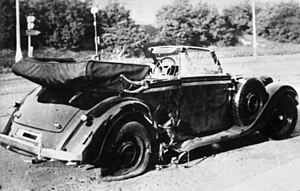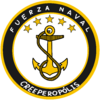Adolfo Cabañeras Moreno
Adolfo Cabañeras Moreno | |
|---|---|
 Photo of Adolfo Cabañeras Moreno in 1933. | |
| 5th Minister of Defense of Creeperopolis | |
| In office December 2, 1931 – May 9, 1944 | |
| Preceded by | Jaime Cabañeras Zapata |
| Succeeded by | Alfonso Cabañeras Moreno |
| 1st Chief of the DINA | |
| In office April 26, 1933 – May 9, 1944 | |
| Preceded by | Position Established |
| Succeeded by | Alfonso Cabañeras Moreno |
| Regional Commander of El Salvador | |
| In office January 3, 1933 – July 16, 1933 | |
| Preceded by | Position Established |
| Succeeded by | Position Abolished |
| Personal details | |
| Born | Adolfo Alfonso Cabañeras Moreno October 20, 1890 San Romero, San Romero, Creeperopolis |
| Died | May 9, 1944 (aged 53) La'Libertad, La'Libertad, Creeperopolis |
| Nationality | Creeperian |
| Political party | Creeperian Pro-Fatherland Front |
| Spouse(s) | María Azaña Negrín (m. 1919; his death 1944) |
| Children | none |
| Alma mater | Academia de Guerra Creeperiano en San Salvador |
| Occupation |
|
| Profession | Military |
| Military service | |
| Allegiance | |
| Branch/service | |
| Years of service | 1900-1944 |
| Rank | |
| Unit | Creeperian Army |
| Battles/wars | |
Adolfo Alfonso Cabañeras Moreno (October 10, 1890-May 9, 1944) was the Minister of Defense of Creeperopolis and the Chief Field Marshal of the Creeperian Army from 1931 to 1944. He was one of the most important and prominent Romerist generals during the Creeperian Civil War.
Adolfo Cabañeras Moreno was appointed as Minister of Defense on December 2, 1931, by Emperor Adolfo IV. Cabañeras remained loyal to Emperor Romero I during the civil war.
Cabañeras was assassinated on May 9, 1944 by the Atheist Red Army.
Early and Personal Life
Adolfo Cabañeras Moreno was born to Jaime Cabañeras Zapata and Anastasia Moreno Hidalgo on October 10, 1882 in San Romero, San Romero. He is the eldest of three children: Adolfo, Alfonso, Alberto. He and his family were practicing Creeperian Catholics. He was absolutely abstemious, a habit that was strictly instilled in him by his father.
Military Career
Cabañeras entered the military in 1900 when he was 18 and studied to become the next Minister of Defense like his father at the San Salvador Imperial Military Academy. In 1904, he graduated as a Colonel in the Creeperian Army. He gradually rose through the ranks and became a Field Marshal in 1930.
His father died on December 2, 1931, leaving Cabañeras to succeed his father as Minister of Defense of Creeperopolis, the most powerful position in Creeperopolis third only to the Prime Minister and the Emperor.
During his military tenure before the civil war, Cabañeras was a supporter and member of the far-right Creeperian Pro-Fatherland Front and an outspoken anti-communist.
Creeperian Civil War
1933-1935
Emperor Adolfo IV died on January 2, 1933. His two sons, Romero I and Miguel VII each declared themselves as the rightful Emperor, with Romero I receiving the support of the right and Miguel VII receiving support from the left. Cabañeras sided with Romero I as he fell in line with his political beliefs.
Emperor Romero I assigned Cabañeras as the most senior officer in the Romerist Army and gave him control of the entire Army.
During the 1933, Cabañeras was tasked with driving out the Miguelists from the client state of El Salvador. His brothers were tasked with driving out the Miguelists from the north and the south, respectively.
Operation Desert Valley was the codename for the Romerist battle plan to drive out the Miguelists from El Salvador and to force the Miguelist puppet, the State of Granada, to capitulate. Cabañeras led his army along the Granada River on their way to the Salvadoran, now Miguelist, capital of Ciudad Los’Ángeles. The operation lasted from 1933 until the fall of Ciudad Los’Ángeles to Cabañeras’ forces in 1935, bringing an end to the Salvadoran War.
1935-1939
With the fall of the Miguelist power in El Salvador and the capture of Ciudad Los’Ángeles, Cabañeras was reassigned to fight the newly formed Senvarian Liberation Front in Senvar and Senvek. His armies were ordered to give no quarter to the Senvarian and Senvekian fighters as the Creeperian government sees them as “lesser races.” As a result, many massacres of prisoners of war occurred under Cabañeras’ command and orders from 1935-1937.
In 1936, Cabañeras suggested that the Creeperian government should establish a maximum facility prison for any prisoners deemed to be fit enough to work. As a result, Tuxtla Martínez Maximum Correctional Facility opened its doors in 1936 and continues to operate to this day.

In 1936, he was again reassigned to lead the army in the Papal War. Cabañeras himself ordered his soldiers to kill any captured SLF or Miguelist soldiers. He told his men: “These animals have attacked the Church of God and has desecrated God’s land, and they must suffer for their crimes against God.”
1939-1944
Cabañeras was a major figure during the Dark Years of Creeperian history.
During the Dark Years, massacres, genocide, ethnocide, and crimes against humanity were widespread. Cabañeras himself personally ordered the killings of Senvarian and Senvekian soldiers during the Papal War from 1939-1944. The Huizúcar Massacre was the first massacre which openly targeted Senvarian civilians which occurred on the Senvar-Zapatista border in 1940. The massacre claimed 2,300 civilian lives.
The Huizúcar Massacre was responded to by the Talnique Massacre where the Senvarian Liberation Front executed 729 Creeperian prisoners of war and 211 civilians.
Each side committed massacres back and forth claiming to “retaliate” and “take revenge” for the previous massacre. Almost all of the massacres committed by both sides were ordered to be committed directly from commanding authorities. Cabañeras himself is responsible for and ordered at least 100 massacres and, at the maximum, up to over 400 massacres, by far the most of any commanding general of either side and even more than Adolfo Rivera López, the commander of the death squad Sombra Negra.
Despite the massacres he committed, Cabañeras has continued to be seen by the Creeperian population as a war hero for the Romerist cause during the Creeperian Civil War.
Assassination
On May 9, 1944, Cabañeras was on his way to a generals’ meeting in La’Libertad when he was assassinated by members of the Atheist Red Army disguised as photographers who threw and anti-tank grenade at his car. The grenade killed Cabañeras, the driver, and Castillianan Field Marshal Luís Sánchez Cerro instantly. The two assassins were injured and knocked over by the grenade. Both were killed on site by the military escort.
Cabañeras’ death was a major blow to Romerist morale and brought the Papal War to a temporary stalemate. His brother, Alfonso Cabañeras Moreno, was appointed as Minister of Defense and he would continue the Papal War in the south. His death also brought an end to the Dark Years and massacres became less frequent. However, Sombra Negra, in retaliation for Cabañeras’ death, massacred over 25,000 civilians, mostly Deltinians, in what became known as the infamous Denshire Massacre.
Legacy and Politics
Cabañeras is viewed as a war hero in Creeperian culture and as a national icon and great leader during the civil war. His legacy is celebrated and remembered on every May 9, the date of his assassination. He is commonly portrayed as a strong, diligent, and powerful figure in Creeperian history.

Cabañeras has had several military academies and streets named after him, mostly in San Romero, his home department.
A detatchment of the Militarist Nationalist Front, a Creeperian death squad (abbreviated FRENAMI), was named after Cabañeras in 1945.
Cabañeras is seen as a war criminal to Senvarian and Senvekian communities due to the several massacres he ordered as Chief Field Marshal.
Cabañeras was an outspoken anti-communist and member of the far-right Creeperian Pro-Fatherland Front (Frente Pro-Patria Creeperiano) political party. He was a firm believer in and supporter of absolute monarchy, militarism, national Catholicism, and ultranationalism.
Orders and Decorations
Domestic Decorations
| Country | Date | Decoration | Post-nominal letters |
|---|---|---|---|
| 1942 | Imperial Order of Miguel the Great | OI MIG | |
| 1941 | Imperial Cross of Alfonso the Great | OI AG | |
| 1939 | Imperial Order of Manuel the Great | OI MAG | |
| 1943 | Order of the Crusaders’ Cross First Class | OCC PC | |
| 1939 | Order of the Crusaders’ Cross Second Class | OCC SC | |
| 1937 | Order of the Star of the White Rose Second Class | OERB SC | |
| 1943 | Imperial Order of the Cross of Carlos the Martyr | OI CCM | |
| 1942 | Order of the Golden Star’s Cross First Class | OCEO PC | |
| 1936 | Order of the Golden Star’s Cross Second Class | OCEO SC | |
| 1933 | Cross of Adolfo I Second Class | CAD SC | |
| 1934 | Cross of Salvador III First Class | CSA PC | |
| 1900 1931 1935 1943 |
Star of the Imperial Army x4 | EEI |
Foreign Decorations
| Country | Date | Decoration | Post-nominal letters |
|---|---|---|---|
| 1939 | Supreme Order of Christ | OSC | |
| 1935 | Order of the Papal Star | OEP | |
| 1941 | Order of the Sacred Cross | OCS |








